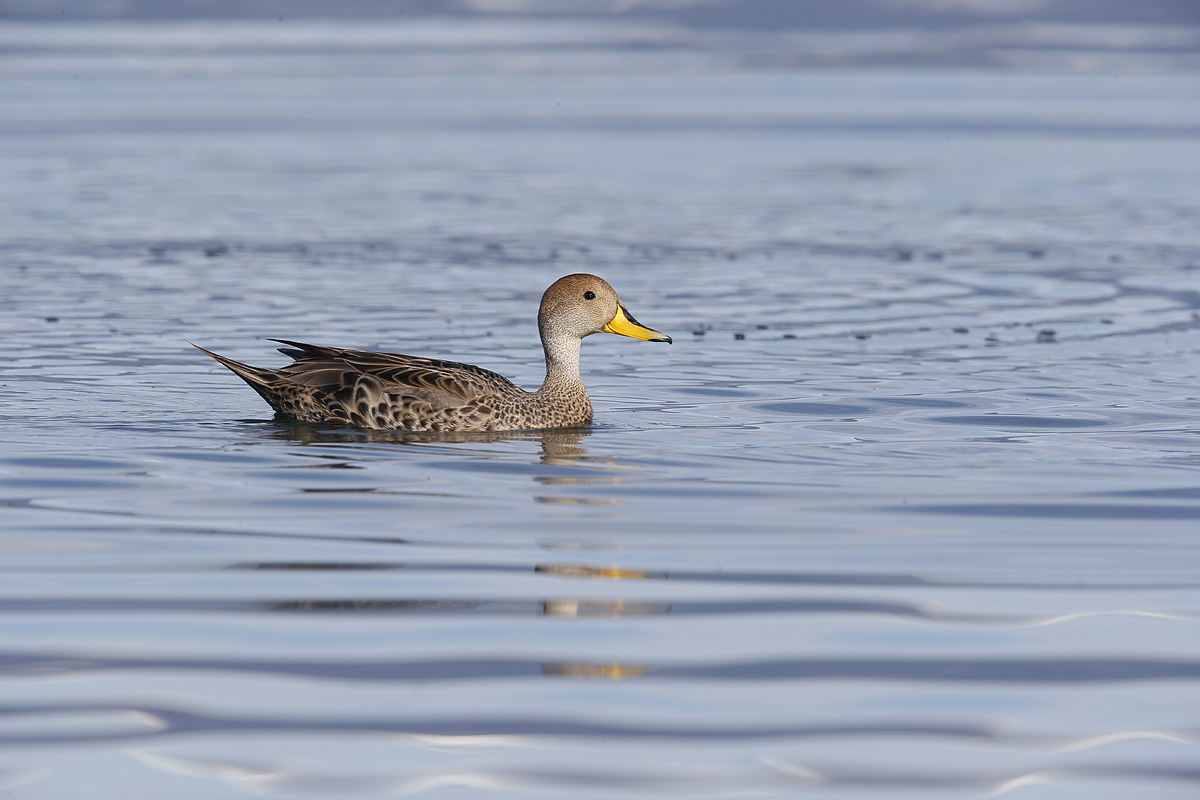
|
|
This Yellow-billed Pintail image was created with the Gitzo 3532 LS carbon fiber tripod, the Mongoose M3.6 head, the Canon EF 600mm f/4L IS II USM lens, the Canon 2x EF Extender III (Teleconverter), and the Canon EOS-1D X. ISO 400. Evaluative metering +1/3 stop: 1/640 sec. at f/11 in Manual mode. Central sensor (by necessity) Expand/AI Servo Rear Focus AF on the upper breast just above the waterline active at the moment of exposure. Click on the image to see a larger version. |
Editing Practice/Yellow-billed Pintail: Keep One or Both?
Editing (not optimizing) your images is an important part of the digital photography experience. One of these years I will get around to doing an Editing Guide… In the meantime, I will start posting some series of similar images taken at almost the same moment and ask you which one or ones to keep and why. Most of you should find these exercises to be extremely valuable.
These two images, the first created on our initial morning at Puerto Natales, Chile at 07:54:47am, were made one second apart. Would you keep one or both? If you feel clearly that one is better than the other, please let us know which one and why. Be sure to click on each image to see the larger version.
The two 1200 pixel wide JPEGs here were created from the extracted JPEGs; both were sharpened, neither has been optimized.
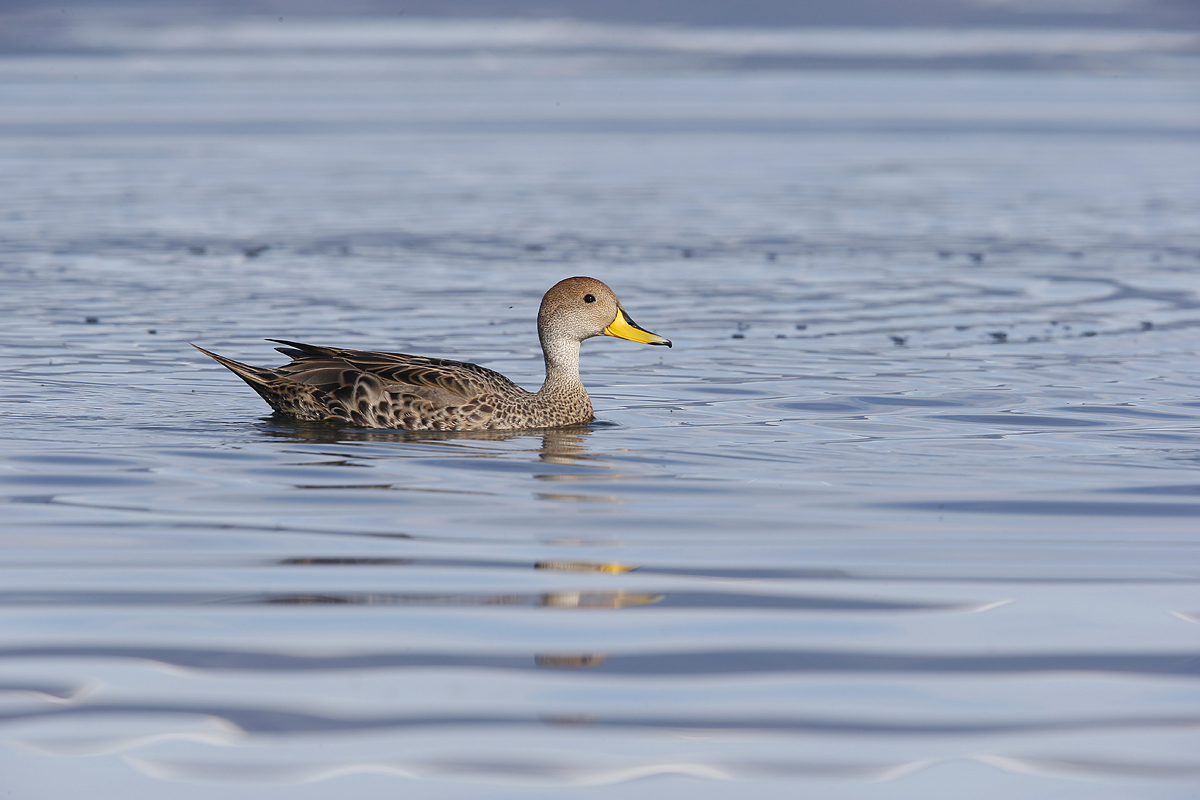
|
|
This Yellow-billed Pintail image was created with the Gitzo 3532 LS carbon fiber tripod, the Mongoose M3.6 head, the Canon EF 600mm f/4L IS II USM lens, the Canon 2x EF Extender III (Teleconverter), and the Canon EOS-1D X. ISO 400. Evaluative metering +1/3 stop: 1/640 sec. at f/11 in Manual mode. Central sensor (by necessity) Expand/AI Servo Rear Focus AF on the upper breast just above the waterline active at the moment of exposure. Click on the image to see a larger version. |
Image Optimization Question
Whichever one you keep, how would you crop it?
EOS-1D X Autofocus Guide
Until I get around to doing a complete user’s guide for the 1D X my 1D X Autofocus Guide will help you to master and get the most out of my all time favorite professional digital camera body. It includes my customized Case setting for photographing birds in flight and in action.
5D Mark III User’s Guide
EOS-5D Mark III User’s can learn to set up and use their cameras exactly as I do. Includes detailed advice on all menu and custom function items, AF suggestions, and all you need to know about creating great in-camera HDRs and Multiple Exposures.
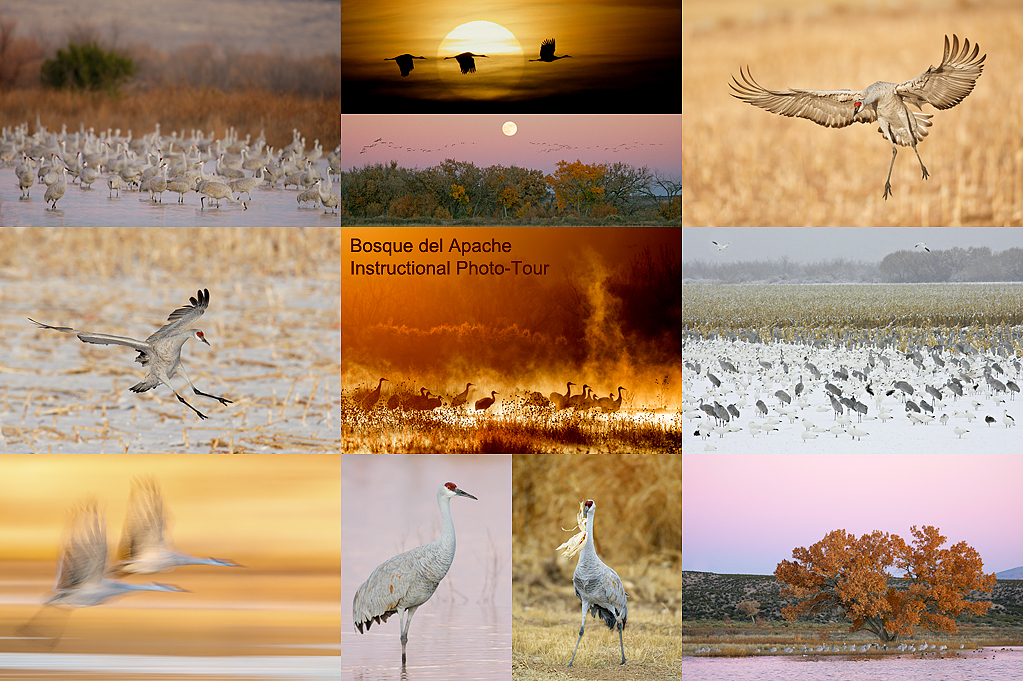
|
|
Bosque Sandhill Crane Composite; click on the image to enjoy a larger version. |
Bosque del Apache 2013 IPT: “The Complete Bosque Experience.” NOV 26-DEC 2, 2013. 7-FULL DAYS: $3399. Co-leader: Denise Ippolito. Introductory Slide program: 6:30 pm on 11/25. Limit: 12/Openings 8.
Please see the info on the short version of this IPT below if you will be spending Thanksgiving with your family.
Tens of thousand of Snow Geese, 10,000 Sandhill Cranes, ducks including point-blank American Wigeon and Wood Duck, amazing sunrises, sunsets, and blast-offs. Live, eat, and breathe photography with one of (if not the) world’s premier photographic educators at one of his very favorite locations on the planet. Top-notch Photoshop instruction. This will make 19 consecutive Novembers at Bosque for me. Nobody knows the place better than I do. Join us to learn to think like a pro, to recognize situations and to anticipate them based on the weather, especially the sky conditions, the light, and the wind direction. Every time we make a move we will let you know why. When you head home applying what you learned will prove to be invaluable. Includes all lunches and the Thanksgiving Buffet at the Crowne Plaza in Albuquerque. I hope that you can join me for what will be an unparalleled learning experience.
There is never a strict itinerary on a Bosque IPT as each day is tailored to the local conditions at the time and the weather. We are totally flexible in order to maximize both the photographic and learning opportunities. There is an introductory slide program on the night before the tour begins. We are up early each day leaving the hotel by 5:30 am to be in position for sunrise. After 18 years we pretty much know where to be when in what sky conditions and what winds. We usually photograph until about 10:30am. Then it is back to Socorro for lunch and then a classroom session with the group most days. We head back to the refuge at about 3:30pm each day and photograph until sunset. Then dinner with the group most nights. We always spend at least one afternoon at the ponds at the Albuquerque Zoo doing Wood Ducks and usually two mornings at New Mexico Tech doing American Wigeons. The rest is Snow Geese and Sandhill Cranes with the emphasis on expanding both your technical skills and your creativity.
A $500 non-refundable deposit is required to hold your slot for this IPT. Your balance, payable only by check, is due now. You will receive an e-mail notifying you of that after you place your deposit. If the trip fills, we will be glad to apply a credit applicable to a future IPT for the full amount less a $100 processing fee. If we do not receive your check for the balance on or before the due date we will try to fill your spot from the waiting list. If your spot is filled, you will lose your deposit. If not, you can secure your spot by paying your balance.
Please print, complete, and sign the form that is linked to here and shoot it to us along with your deposit check (made out to “Arthur Morris.”) You can also leave your deposit with a credit card by calling the office at 863-692-0906. If you register by phone, please print, complete and sign the form as noted above and either mail it to us or e-mail the scan. If you have any questions, please feel free to contact me via e-mail.
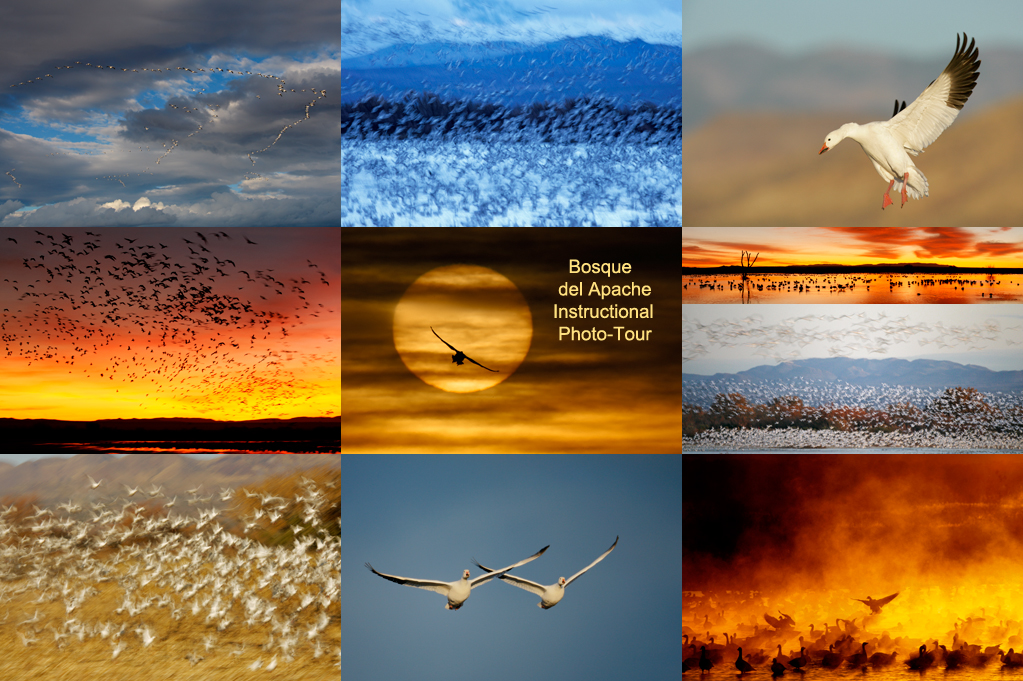
|
|
Bosque Snow Goose Composite; click on the image to enjoy a larger version. |
Bosque del Apache 2013 IPT: “The Short Version.” NOV 30-DEC 2, 2013. 3-FULL DAYS: $1199. Co-leader: Denise Ippolito. Introductory Slide program: 7:30 pm on 11/29. Limit: 12/Openings 4.
Tens of thousand of Snow Geese, 10,000 Sandhill Cranes, amazing sunrises, sunsets, and blast-offs. Top-notch Photoshop instruction. This will make 19 consecutive Novembers at Bosque for artie. Nobody knows the place better than he does. Join us to learn to think like a pro, to recognize situations and to anticipate them based on the weather, especially the sky conditions, the light, and the wind direction. Every time we make a move we will let you know why. When you head home applying what you learned will prove to be invaluable. Includes all lunches. I hope that you can join us for these three great days; they will offer a great learning experience.
There is never a strict itinerary on a Bosque IPT as each day is tailored to the local conditions at the time and the weather. We are totally flexible in order to maximize both the photographic and learning opportunities. There is an introductory slide program on the night before the tour begins. We are up early each day leaving the hotel by 5:30 am to be in position for sunrise. After 18 years we pretty much know where to be when in what sky conditions and what winds. We usually photograph until about 10:30am. Then it is back to Socorro for lunch and then an informal Photoshop/image review session with the group most days. We head back to the refuge at about 3:30pm each day and photograph until sunset. We may spend an afternoon at the ponds at the Albuquerque Zoo doing Wood Ducks and we may spend a late morning at New Mexico Tech doing American Wigeons. The rest is Snow Geese and Sandhill Cranes with the emphasis on expanding both your technical skills and your creativity.
A $500 non-refundable deposit is required to hold your slot for this IPT. Your balance, payable only by check, is due now. You will receive an e-mail notifying you of that after you place your deposit. If the trip fills, we will be glad to apply a credit applicable to a future IPT for the full amount less a $100 processing fee. If we do not receive your check for the balance on or before the due date we will try to fill your spot from the waiting list. If your spot is filled, you will lose your deposit. If not, you can secure your spot by paying your balance.
Please print, complete, and sign the form that is linked to here and shoot it to us along with your deposit check (made out to “Arthur Morris.”) You can also leave your deposit with a credit card by calling the office at 863-692-0906. If you register by phone, please print, complete and sign the form as noted above and either mail it to us or e-mail the scan. If you have any questions, please feel free to contact me via e-mail.
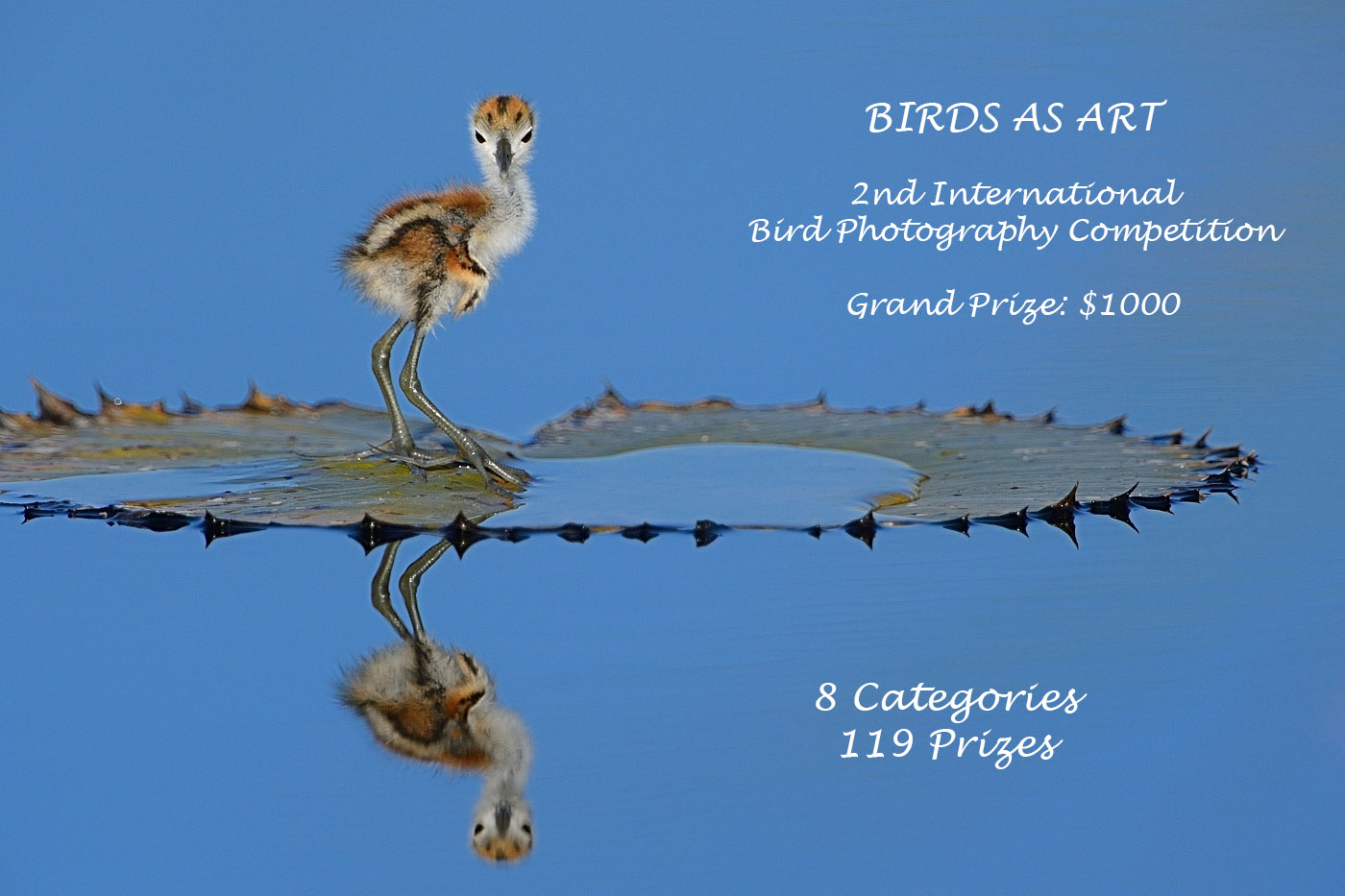
|
BIRDS AS ART 2nd International Bird Photography Competition
Learn more and enter the BIRDS AS ART 2nd International Bird Photography Competition here. Twenty-five great prizes including the $1000 Grand Prize and intense competition. Bring your best.
2014 Tanzania Summer Safari
If you are interested in joining us in Tanzania next summer please shoot me an e-mail and I will be glad to forward you the PDF with dates, itinerary, and price.
Support the BAA Blog. Support the BAA Bulletins: Shop B&H here!
We want and need to keep providing you with the latest free information, photography and Photoshop lessons, and all manner of related information. Show your appreciation by making your purchases immediately after clicking on any of our B&H or Amazon Affiliate links in this blog post. Remember, B&H ain’t just photography!




Amazon
Everyone buys something from Amazon, be it a big lens or deodorant. Support the blog by starting your search by starting your search by clicking on the logo-link below. No purchase is too small to be appreciated; they all add up. Why make it a habit? Because I make it a habit of bringing you new images and information on an almost daily basis.
Typos
In all Bulletins, feel free to e-mail or leave a comment regarding any typos, wrong words, misspellings, omissions, or grammatical errors. Just be right. 🙂
IPT Info
Many of our great trips are filling up. Two great leaders ensure that you will not learn more anywhere about how to make great images. Click here for the schedule and additional info.














Keep the second image.
To my eye there is slightly more closure at the far distance, top of image.
This makes the Pintail more prominent in the scene.
What a beautiful color pattern on the bird.
Fascinating. I looked at them for quite a while and couldn’t see any significant differences. Then I read the comments–7 of them–and went back, and still can’t see enough difference to make a choice; I’m not sure I even can see the differences mentioned in the comments, except that the eye in the reflection is a bit clearer in the second image. I would be delighted to have made either one and probably wouldn’t delete either.
I like first one. The second seems to be turning away from the camera a little bit.
I am going to go against the trend of what is posted so far and select the first image. What decided for me is in the first(number 2894)image the duck’s neck is slightly more elongated and pleasing to me. In addition the 2nd image has some sort of insect or something right behind the ducks head that would need removal in optimization. I agree with the comments about the activity in the water being further from the bill in the 2nd but the position of the duck’s neck wins out for me in the first.
Looking forward to what you choice is and why!
Take Care,
Ken
Both views are very nice. I like the second one probably because of the debris being farther from the the end of the beak. Using PhotoShop I would probably save the first shot to use as a layer on second shot. While on the top layer I would switch to difference to line up the water ripples. Then back on normal I would completely mask it. Then with a soft white brush at 50% I would dab at the debris for the desired effect. If necessary I would clone with the same soft brush to finish cleaning the debris. Then I would crop a little off the left and more off the top. I love the reflection and might even try some contrast or sharpening. A little overall saturation might be nice.
Keep both and use compare to look at both side-by-side. Might as well make use of the available tools.
If I could only keep one it would be the second because the eye is visible in the reflection.
I agree with Raleigh
A lovely Pintail. At first glance I would keep the second, because I like the water around the bird slightly better. But if I just had these two, I would probably keep both until I was ready to finish processing. Sometimes when processing I’ll discover something about one of the images, such as marginal difference in sharpness, that causes me to change my first impression. I’d consider a 16:9 pano.
I would keep the second one. The bird’s pose and sharpness is the same in both. The second has a little more room above the head to the dark line of water. It also has more room to the first dark dot in front of the bird, more comfortable cloning space for me. I would crop it into a pano. Cut off the left just in front of the leftmost dark dot that the tail points to. Cut off the bottom just above the higher bit of reflection showing some yellow. Cut off the top just below the upper dark water, keeping the lowest semi-dark line and some lighter above it. Take nothing off the right, I like the circular waves. Interestingly, this is the crop I chose just for appearance, yet the lower left third intersection falls on the bird’s back just in front of the wings. I’ll send the crop by email FYI.